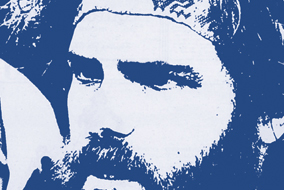
American “Yippee” leader Jerry Rubin urged UBC students to “cast off the shackles of society.” - photo courtesy of UBC Archives UBC Reports | Vol. 53 | No. 12 | Dec. 6, 2007
Invasion!
Many Vancouverites Recall the 1968 “Uprising” that Saw 3,000 Students Take Over the UBC Faculty Club
By Basil Waugh, with notes from archived editions of UBC Reports and The Ubyssey
It was a quiet day at the UBC faculty club on Oct. 24, 1968 -- until several hundred students, a presidential pig candidate, and an American radical joined the faculty for lunch.
Students drank the faculty’s liquor, smoked their cigarettes, burned flags, and swam nude in the patio pool. Rock bands cranked out psychedelic jams until the small hours. Revolution, among other substances, was in the air.
To some, the sprawling be-in was the largest display of UBC student power since the 1922 Great Trek, ultimately giving students more say in how the university was run. To others, it was a case study in political clichés and revolutionary posturing. One thing is certain: it was the wildest time the then-private club -- now UBC’s Sage Bistro restaurant -- had ever seen.
“The idea was to liberate a place that represented the power of the establishment,” says UBC alumnus Stan Persky, author of 26 books and former Globe and Mail books columnist, who helped to negotiate an end to the takeover as it threatened to erupt into violence. “So organizers targeted the faculty club, which at the time was off-limits to students and staff,” says the Capilano College philosophy instructor.
Herbert Rosengarten, a then-junior English professor, was in the games room when the motley crew began pouring in. “At first, I was mostly afraid for club’s new pool table, which had cost members a lot of money. After we secured the room, I went upstairs and watched someone burn a U.S. draft card. It had nothing to do with UBC or Canada, but I guess it was meant as a symbol of radical revolution.”
“Many students were there because they wanted to have a good time and wanted to show the faculty they could do this,” adds Rosengarten, who recently retired from UBC after 41 years. “They were not there in support of any particular cause or grievance, just voicing their opposition to the Vietnam war and government in general. The few formal speeches I heard were very clichéd, mainly about Vietnam and student rights.”
Setting the stage was a pre-invasion noon-hour campus speech by traveling U.S. radical Jerry Rubin, a member of the Youth International Party, or Yippies. Wearing a National Liberation Front of South Vietnam flag as a cape, Rubin urged an audience of 1,500 students outside the Student Union Building to liberate themselves from all forms of establishment.
He urged students to “cast off the shackles of society” and denounced universities as “baby-sitting establishments.” Rubin then introduced the Yippee presidential candidate, Pigasus the Pig. “Why vote for half-pigs like Nixon, Wallace and Humphries, when you can have the whole hog? Pigasus.”
At the end of the speech, Rubin re-emphasized the need for students to take action and liberate themselves. “We’ve got all these people here, now let’s do something. Is there any place on campus that needs liberating?”
“The faculty club,” yelled out a half-dozen members of the crowd -- and off they went.
The location had clearly been set in advance, as local media were present when the horde of students began flooding in. According to the Ubyssey student paper, Rubin and small group of UBC students laid plans for the occupation the day prior. Speaking at SFU, Rubin allegedly mentioned a “pig parade” culminating with a march on the faculty club.
According to estimates, as many as 3,000 people crammed into the faculty club over the next few hours as word spread. There were reports of socialites and other non-students, including Town Fool Joachim Foikus, making the scene. By morning, satisfied with a good party, all but the most hardcore had made their way home.
At about 10 a.m. on Oct. 25, 1968, engineering students began amassing outside the faculty club, threatening to clear out the remaining interlopers by force. That is when Persky and Bob Rowen, a popular philosophy professor, successfully convinced the remaining students to leave. “We tried to tell them that they had achieved everything they wanted to do,” says Persky. “What was the point of staying longer and getting hauled off?”
Violence averted, the remaining invaders left the club at around noon, shortly before UBC’s Alma Mater Society, which denounced the occupation, hosted a mass meeting outside the SUB attended by nearly 5,000 students. Students voted for a proposal by UBC President Kenneth Hare and AMS president Dave Zirnhelt, who later served in the B.C. legislature for the New Democratic Party, to stage a campus-wide day of reflection to try to make sense of the occupation and address student concerns.
At the resulting “teach-in,” held on Oct. 30, 1968, several classes persuaded their professors to scrap exams. As for longer-term effects, students were given an increased role in UBC’s governing bodies over the next five years: In the early 70’s, the number of students on the university’s senate increased from four to 12, and in 1974, two students were elected to UBC’s board of governors for the first time. |
